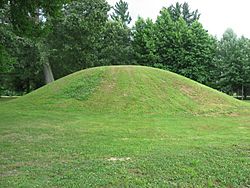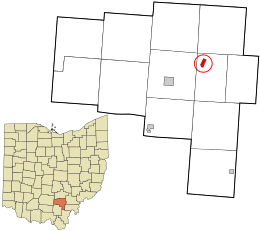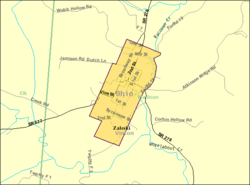Zaleski, Ohio facts for kids
Quick facts for kids
Zaleski, Ohio
|
|
|---|---|
|
Village
|
|

The Ranger Station Mound, part of the Zaleski Mound Group
|
|

Location in Vinton County and the state of Ohio.
|
|

Detailed map of Zaleski
|
|
| Country | United States |
| State | Ohio |
| County | Vinton |
| Township | Madison |
| Area | |
| • Total | 0.41 sq mi (1.07 km2) |
| • Land | 0.40 sq mi (1.05 km2) |
| • Water | 0.01 sq mi (0.02 km2) |
| Elevation | 745 ft (227 m) |
| Population
(2020)
|
|
| • Total | 230 |
| • Density | 569.31/sq mi (219.86/km2) |
| Time zone | UTC-5 (Eastern (EST)) |
| • Summer (DST) | UTC-4 (EDT) |
| ZIP code |
45698
|
| Area code(s) | 740 |
| FIPS code | 39-88028 |
| GNIS feature ID | 2399755 |
Zaleski is a small village located in Vinton County, Ohio, in the United States. In 2020, about 230 people lived there.
Contents
History of Zaleski
Ancient Mounds
Long ago, six large earth mounds were built in the Zaleski area. These mounds were made by the Adena culture, a group of Native American people who lived here before recorded history.
Three of these ancient mounds are still standing today. They are called the Markham, Ranger Station, and Zaleski Methodist Church Mounds. Together, they form the Zaleski Mound Group.
Village Beginnings
Zaleski was officially started in 1856. It was created as a place for people who worked in mining. The village got its name from Peter F. Zaleski. He was a Polish-American official who worked for the mining company that owned the land.
In the past, Zaleski had a special factory called an iron blast furnace. This factory was used to make iron from raw materials.
Modern Improvements
In February 2014, Zaleski began building a public sewer system. This was a big step for the village. It made Zaleski one of only three villages in Vinton County to have a public waste facility. The other two villages are McArthur and Hamden.
Geography of Zaleski
Location and Area
Zaleski is a small village in Ohio. According to the United States Census Bureau, the village covers about 0.45 square miles (1.17 square kilometers). Most of this area is land, with a very small part being water.
Waterways
The village is located on Raccoon Creek. This creek is a smaller stream that flows into a larger river. Raccoon Creek eventually flows into the Ohio River.
Population of Zaleski
| Historical population | |||
|---|---|---|---|
| Census | Pop. | %± | |
| 1870 | 690 | — | |
| 1880 | 1,175 | 70.3% | |
| 1890 | 802 | −31.7% | |
| 1900 | 577 | −28.1% | |
| 1910 | 476 | −17.5% | |
| 1920 | 395 | −17.0% | |
| 1930 | 367 | −7.1% | |
| 1940 | 374 | 1.9% | |
| 1950 | 388 | 3.7% | |
| 1960 | 336 | −13.4% | |
| 1970 | 304 | −9.5% | |
| 1980 | 347 | 14.1% | |
| 1990 | 294 | −15.3% | |
| 2000 | 375 | 27.6% | |
| 2010 | 278 | −25.9% | |
| 2020 | 230 | −17.3% | |
| U.S. Decennial Census | |||
2010 Census Information
In 2010, the village of Zaleski had 278 people living there. These people lived in 123 households. About 80 of these households were families.
Most of the people in Zaleski were White, making up 98.2% of the population. A small number of people were from other racial backgrounds.
About 26% of the households had children under 18 years old living with them. Many households were married couples living together. The average household had about 2.26 people.
The average age of people in Zaleski was 43 years old. About half of the residents were male and half were female.
See also
 In Spanish: Zaleski (Ohio) para niños
In Spanish: Zaleski (Ohio) para niños

